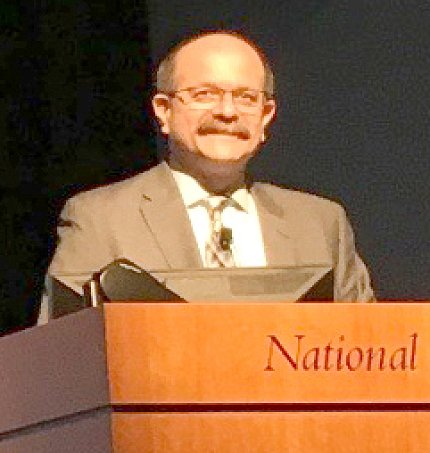Schiffman Inspires, Educates On Cervical Cancer

Listen up, those of you who have been around NIH for only a cup of coffee: Dr. Mark Schiffman’s Robert S. Gordon Jr. Lecture on May 3 might well have served as a primer on the meaning of an NIH career. It was heartfelt, impassioned, honest, funny, encouraging and offered good news about preventing cervical cancer via vaccination.
And it only cost NIH about $30,000 in lost productivity among those who attended, according to epidemiologist Schiffman’s calculations.
A senior investigator in the Clinical Genetics Branch of NCI’s Division of Cancer Epidemiology and Genetics, Schiffman, who calls himself “a preventive medicine doc,” has spent his entire 35-year career at NIH.
“I’m like a microscope—I keep focusing down, clicking further and further down to a greater understanding” of the natural history of human papillomavirus, which was tied to the development of cervical cancer by Nobel prize-winning studies in the early 1980s. “I’ve been studying one thing—HPV—for 30 years because I wanted to make an impact.
“Whole new fields are opening up,” he continued. “There is an incredible richness to the continuing story. I know I’ll never get to the end of it, but I’m sticking with it until they carry me out.”
Schiffman’s single-mindedness mirrors that of the lecture’s namesake, from whom he learned an important lesson.
“Sometimes, Dr. Gordon [who died at age 59 in 1985] would fall asleep during meetings. What we didn’t know at the time is that he was dying of cancer. But he never complained. I thought, ‘Damn. This guy is really dedicated.’”
When Schiffman arrived on campus in 1983, having trained in the PHS epidemiology program, he was intimidated. “I remember when I was a first-year fellow. My legs were shaking. I was incredibly fearful that I would have nothing to contribute. Now, I have friends all around me. This is my home.”
Speaking on “The changing epidemiology of HPV and cervical cancer: From etiology, to validation of prevention methods, to dissemination,” Schiffman said that, during the early years of investigation, “I would be so excited that I didn’t know what city I was in.” Back then, the field attracted only a handful of investigators; today’s HPV meetings draw thousands.
“The sense of being on a team was wonderful,” he recalled. “We were all looking for a signal in the midst of noise.”
His mentor at Johns Hopkins, where he earned his M.P.H. in epidemiology, was Dr. Abraham Lilienfeld, whose motto was, “Epidemiology is a butcher shop—don’t use a scalpel.” Schiffman said he spent 5 years measuring HPV in all its aspects.
“We were trying to measure without error,” he said. “That kind of work might not even be funded today. We made a lot of mistakes, and we wasted a lot of money, but you need to have that kind of room in order to do a case series—that’s often useful in the search for causation.
“We were obsessed over reducing misclassification,” Schiffman continued. He and his colleagues had to “start over frequently. We kept asking simple questions, knowing that, eventually, the answers would be profound.”
It turns out that there are more than 200 HPVs, only about a dozen of which cause cancer. HPV1, which causes foot warts, and HPV2, which causes warts on fingers, arise with characteristic timing, right about when kids least want to be made fun of in pool locker rooms or middle school hallways. More than 95 percent of cervical cancer cases are linked to HPV; those harboring oncogenes E6 and E7 are the most dangerous. But their invasive work proceeds slowly, over decades.
Early attempts to categorize the disease’s progression, often based arbitrarily on microscopic appearance, turned out to be poorly reproducible and not a true reflection of HPV’s natural history.
“It’s rare for a biomarker to link closely to disease,” Schiffman said. “Most fail as indicators. But there is fierce inertia against changing familiar reference standards…I think we should question all biomarkers, even if they are clinically established, but especially if they represent ‘disease.’ Treat everything as a predictor variable.”
In his view, a good test correctly assigns what action the clinician should take.
Schiffman owned up to “an instructive mistake” involving HPV66. It briefly looked like a reliable signpost to the development of cervical cancer, but eventually failed as a cause.
There may be too many tests and algorithms today, he cautioned. “People can’t keep up.”
But all that testing has led to “a massive evaluation of risk” that is now under way among cancer researchers, Schiffman said. Apps are taking the place of algorithms as clinicians and patients seek simplified recommendations.
Schiffman believes that science can “achieve truly high impact against cervical cancer…There are faster ways than what we are doing, if we’re serious about eradicating cervical cancer.”
He applauded his institute’s acting director Dr. Doug Lowy—himself an HPV researcher—for embracing an eradication approach. Schiffman acknowledged that it will take big resources to go down this path, but said such an effort is justified: “This is a common infection that leads to a common cancer.”
During a brief Q&A, Schiffman got to defend again his preference for frank debate about any scientific finding: “Sometimes I think we don’t argue enough anymore. But it’s just good science. You need those people who want the greater truth.”
He also said that there is an ongoing trial with the Gates Foundation to determine whether current vaccines for HPV indeed last 7-9 years. “I think that’s plenty long enough—you don’t need lifetime durability to fight cervical cancer. But I’m not sure what the case is in men.”
Those who may find themselves a quart low in their zeal for the NIH mission can watch Schiffman’s entire talk at https://videocast.nih.gov/summary.asp?Live=23318&bhcp=1.
